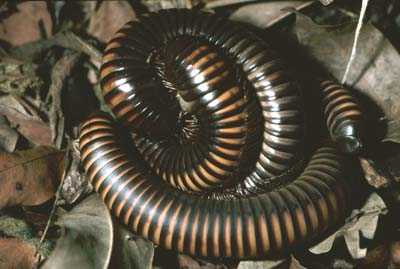|
MILLIPEDE |
|
|
Millipedes are found all over the world but are most common in tropical areas. Most millipedes are herbivores (they eat plants). They are found under logs and stones, in moist soil, and under leaf litter. The reason that millipedes are considered beneficial bugs is that they feed on rotting vegetation. Millipedes contribute to the environment because they shred plant materials that have fallen to the ground, creating more food for fungi, bacteria and other small organisms. These small organisms are then eaten by larger worms and birds. You can find more information about how millipedes and other beneficial bugs contribute to the "Circle of life" by going to the website at http://compost.css.cornell.edu/invertebrates.html Creatures like the millipede (which is black and has many, many legs) seem unpleasant to some people, but they are not dangerous. The gentle millipede does not bite and it performs a valuable service for humans: it is one of nature's best composters--eating decaying plants and returning the organic matter to the soil. Though most millipedes feed on decaying vegetation on the ground and in compost, there is one species of millipede that lives in the water inside caves. These millipedes have a mouthpart that has been changed or "modified" so that they can remove organic clay, and limestone particles from the moist surfaces of rock inside caves. They clean the limestone and clay of plant materials like mold, that would grow quickly anywhere that there was light in a cave. BACKGROUND INFORMATION: Millipedes are not the same as centipedes. Millipedes have two pairs of legs per body segment. Millipedes are often called "1000-legged" or "rain" worms. They look a little like worms because they have rounded body segments. The head is also rounded with short antennae. Species can vary in length from less than 1 inch to more than 2 inches. They vary from light brown to black in color. Millipedes do NOT like the light and tend to hide under logs and other debris, and will often burrow into the ground. Their hard exoskeleton that gives them some protection against predators. When threatened, they will coil up in a ball to protect the more vulnerable underside. Some millipedes also have a poisonous or harmful secretion that they use to scare away predators. Millipedes do not use their eyes very much. In fact, some scientists believe that millipedes are blind. They use their antennae to move around. If you watch a millipede you will see that they continually tap the ground as they move along, like a blind person with a cane. Millipedes will periodically molt, or shed their exoskeleton. Every time they molt, millipedes add more body segments and legs so they get longer and bigger. Millipedes are adults when they are about two years old, and most of them live between 5 and 10 years. These beneficial bugs will work in you compost pile for a long, long time. |

